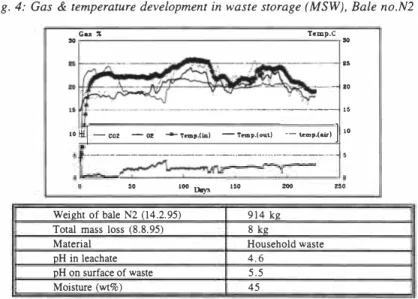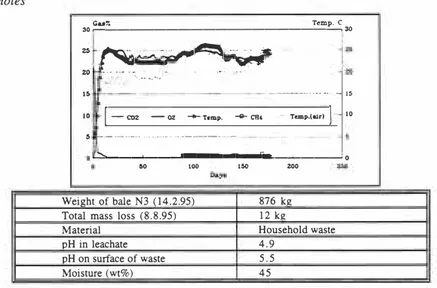WASTE MANAGEMENT AND THE ENVIRONMENT KALMAR. SWEDEN, November 5•7, 1 997
3
ROUND BALING - A NEW
TECHNOLOGY FOR STORING AND
TRANSPORTING OF WASTE
Lars-Ake Briinnstrom BALA Press AB, Nossebro SwedenINTRODUCTION
The society is demanding that we find long-term solutions to the problem of fu ture waste recycling. It is therefore that, i.e., life-cycle analyses of different pro ducts are performed more frequently. Source-sorting and reclamation of waste is now an obvious necessity.
The contribution of BALA Press AB to the rational use of materials and the pro tection of the environment is a round bale press, a world-patented innovation which revolutionises the handling of waste. Garbage, residual waste and industrial materials can be compressed to a fraction of the original volume and enclosed in cylindrical bales.
THE BALER FUNCTION
The system is based on a patented press design which compresses and wraps the waste into a cylindrical, hermetically sealed bale. The process is completely au tomized and takes 3-4 minutes per bale. The machine develops a large compres sive force with a minimum of energy consumption.
It is available in different versions; stationary or semi-mobile. Today more than 35 press units are in operation in 10 different countries.
Lars-Ake Brannstr0m, Sweden 33
WASTE MANAGEMENT AND THE ENVIRONMENT KALMAR, SWEDEN, November 5-7, 1997
The material is fed into the bale A net or a film is introduced chamber until full pressure is reached. to fix the form of the bale.
The press opens and the bale is lifted The bale is now wound with stretch film to the wrapping unit. while the press returns to its working
mode and begins the pressing of next bale.
Lars-Ake BrannstrOm, Sweden
WASTE MANAGEMENT AND THE ENVIRONMENT KALMAR, SWEDEN, November 5-7, 1997
The wrapped bale is off-loaded ready for removal to intermediate storage. The pro cess, completely computercontrolled, takes 3-4 minutes per bale.
CHARACTERISTICS OF BALES
A large variety of materials can be baled with the BALA round balers.
After pressing and wrapping, the bale is approximately 1,2 m high and has a di ameter approximately 1,2 m. The density of the waste before baling varies natu rally in accordance with its constituents. After baling, the volume is reduced by a factor of 2,5 to 4,0 and the bale weight vary dependent on type of material. Ty pical weights for household-wastes are 600 to 900 kg.
The bales are stackable, which further reduces the storage area required. The number of plastic layers applied to the bales and the UV-resistance of the plastic determines the storage time. Bales have in some cases been stored for two years without any problems. The baling and storage of wrapped bales can preferably be located directly adjacent to the incineration installation or final storage. If the baling is located at a distance from the storage and/or incineration the bales can be transported by ordinary lorries with high transport utilization.
The bales can be opened in different ways when their contents are to be used or incinerated. One method is to crush the bales with a front loader or a similar ma chine. BALA Press have developed a special bale breaker which also reclaims the netting and plastic wrapping. The burning of baled waste has been experienced positively by the personnel at the incinerator plants mainly because of the uni form energy content of the bales and the preliminary inspection of the material made before the baling.
WASTE MANAGEMENT AND THE ENVIRONMENT KALMAR, SWEDEN, November 5•7, 1997
Bale Weights Measure: � 1,2 x 1,2 m, Volume: 1,3 m3 Material Corrugated paper Mixed board/paper Plastic bottles Plastic Industrial waste Tyres, in strip form Tyres, whole Wood Wood shavings Wood chips Turf Silage
Energy �ass, Straw
Household waste with organic matter Household waste without organic matter
Weight kg 400-600 kg 570-800 kg 150-200 kg 550-600 kg 450-600 kg 800-900 kg 550-650 kg 500-600 kg 370-420 kg 630-700 kg 750-950 kg 700-1 500 kg 330-450 kg 800-1 150 kg 600-700 kg
STORAGE OF WASTE IN ROUND BALES Degradation processes in the stored waste
Any waste storage involves two different interval processes; aerobic and anaero bic. In the aerobic phase the main degradation is oxidation reactions which pro duce CO2• Combustion and thermal degradation can be the consequence of this phase. This period was found to be very short in the case of baling method. During the anaerobic degradation, three metabolically different groups of bacte ria become active and result hydrolytic, acetogenic and finally methanogenic de gradations. This biodegradation process by which the organic substances are ac ting as a nutrient as well as an oxidation agent is a result of co-ordinated action of many different bacteria species in sequential reactions. Any disturbance in such a consecutive system can delay or accelerate some of the biochemical step reactions and affects on degradation rate and energy/mass losses in the stored material (the idea behind baling technique in the below study).
Lars-Ake Brt!nnstrOm, Sweden
WASTE MANAGEMENT AND THE ENVIRONMENT KALMAR, SWEDEN, November 5•7, 1997
Study of storing waste in round bales
Tests of storing waste in round bales has been carried out both by Lunds Univer sity in Sweden as well as DEKRA Umwelt GmbH in Germany.
At the study made by Lund University gas and temperature development, materi al and energy losses in the stored bales were measured.
The source of waste used in this trial was MSW from Nossebro, Borlange and Stockholm area. Three different types of waste were stored, RDF (shredded), source separated and unsorted household waste. Organic materials which varies in composition with locations constituted the main fraction.
Results from the study are:
No considerable temperature increase or methane production were observed even after one year and most biological and oxidation reactions were virtually stop ped.
In order to study the effect of particle size, shredded household waste was used in the same way. However, formation of methane was not either observed in this ca se.
The odour emissions accompanying the bale of MSW was found to be mainly the result of production of fatty acids that generated during the early phase of decomposition.
The below graphs shows the gas and temperature development for some of the bales used in the Lunds University study. Also one graph from the DEKRA study is shown as a reference.
�
'---·--·�
.
5.5 45 ---,1• 5.5WASTE MANAGEMENT AND THE ENVIRONMENT KALMAR, SWEDEN, November 5-7, 1997
Fig_ 3: Gas & temperature development in stored waste (MSW), Bale no.NJ
Gas X Temp.C •o�---....;...�30
..
20 10 10 temp.(&ir)nil
t=J_-I: coz - 02 _._ Temp. 0 0 0 .. � � -D&J" Weieht of bale NI (14.2.95) 976 kQTotal mass loss (8.8.95) 8 kQ
Material Householdwaste
oH in leachate 4.2
oH on surface of waste
Moisture (wt%)
Fig. 4: Gas & temperature development in waste storage (MSW), Bale no.N2
�
Cu,; Temp.C..
--110
10
Hf.I -
CO2 - � ... Tl'lllp.(Ln.) - Trm.p.(ou.L) -- t.emp.(air)II
tO•• 100 Doy,,
...
...
...
Weight of bale N2 (14.2.95) 914 kg Total mass loss (8.8.95) 8 kg
Material Household waste
pH in leachate 4.6
pH on surface of waste
Moisture (wt%) 45
Lars-Ake BrannstrOm, Sweden 38
WASTE MANAGEMENT AND THE ENVIRONMENT KALMAR, SWEDEN, November 5-7, 1997
Fig. 5: Gas & temperature development in stored waste (MSW), Bale no.N3 with holes Gu% Temp. C so---'----,30
:
. ��-� '-.·- -.-·-�
-:�
--����
••<-••-·-·-··· ·-· -- - 15 1• lO 10 ··I -
C'02 - 02 � Temp. � CH♦ ···· Tem.p.(air�I···
5 ---·-··• ··-· ····-·
·---··-D---'---1111111..__...._ __ _jo
60 100 160 zoo
Weight of bale N3 (14.2.95) 876 ke
Total mass loss /8.8.95) 12 ke
Material Household waste
oH in leachate 4.9
oH on surface of waste 5.5
Moisture (wt%) 45
Twelve holes with a size of 12x8 cm was made on the lower and upper part of this bale in order to facilitate diffusion of air into the waste material, however, no noticeable effect was observed.
Fig. 6: Gas & temperature development in stored waste (MSW, increased moistu re), Bale no.N4
..
..
:,0
,t-ca• -coi -02 �Temp.
10
lll..--�---..__1.
.I
--- ,...,.(.ur)I
.. .
100 160
..
...
Weight of bale N4 (14.2.95) 1010 kg
Total mass loss (8.8.95) 50 kg
Material Household waste
oH in leachate 4.5
oH on surface of waste 5.5
Moisture (wt%) 61
The moisture content of this bale was artificially increased by adding water into the waste before baling.
�
WASTE MANAGEMENT AND THE ENVIRONMENT KALMAR, SWEDEN, November 5-7, 1997
Ballen Nr. 24 (mit Folienabdeckung)
i�lr
r�""'1
�,.1
g"
J"
µ....,_,, __
.,...======::::;=====·�o--t
..
,. .,
..
ZIIIIJIT...,.
Field experiences of storing waste in bales
The suppliers of district heating in Scandinavia using waste material as fuel in their production are most often dependent on seasonal storage of the waste. The demand for heating is periodic but the volume of waste produced remains constant during the year.
The storage of waste has most often been in the open air. This has resulted in problems with waste flying around, birds, rats and fires. In addition, energy value will be Jost by rain penetrating the material and starting a decomposition process. Plants which have not been able to store the summer surplus of waste have most often been unable to use profitably the heat produced from its combustion or have dumped the superfluous material. Baling also allows waste to be delivered to the incinerator plants even during inspection and maintenance shut-downs. To day considerable positive experience has been achieved by full scale baling ope rations and storages among others at:
Type of Number of bales produced
material -94
-�
-96 -'.17 Borlange RDFSS 6 600 8 100 7 400 6 900 Energi Sweden GRAAB Got- MSW !SW 4 500 28 500 28 000 henburg S we-denUmeA Energi MSW ISW II 100 10 000 II 800
Sweden
Lidkopings MSW ISW 6 000 10 500
Varmeverk Sweden
MSW= Municipal Solid Waste, !SW= Industrial Solid Waste, RDF = Fuel Fraction, SS = Source Soned
Lars-Ake Brannstrom, Sweden
WASTE MANAGEMENT AND THE ENVIRONMENT KALMAR, SWEDEN, November 5-7, 1997
Tekniska Verken Linkoping, 11 500 bales produced 1995
SUMMARY
For years of full scale baling operations has proven the technology to be very suitable for storing of waste by:
• no fermentation
• preservation of material properties, almost no energy and mass loss
• less smell
• less fire risk, no risk for selfignition • clean and tidy storage and transportation • reduced volume
• higher energy value, due to water tight storage
• outdoor storage possibility
economically and environmentally good when seasonable variations are even out at waste to energy plants.
WASTE MANAGEMENT AND THE ENVIRONMENT KALMAR, SWEDEN, November 5-7, 1997
REFERENCES
Baling-storage of waste material, A case study from district heating plants in
Sweden and Norway, Leif Johansson, Borliinge Energi
Praktisk erfarenhet med lagring av briinnban avfall i ett svenskt avfallssiillskap
( Experience from storing of burnable waste in a Swedish waste management,
Carl-Ame Pedersen, GRAAB, Gothenburg association
Storage of waste-Fuel by baling technique, Feraydoon Tamaddon and William Hogland, Lund University
Zwischenbericht zum Pilotversuch far Abfallzwischenlagerung
Manfred Faykes and Tom Scheid!, DEKRA Umwelt GmbH
✓
GRAAB recovery station at Tagene, Gothenburg with a storage of 28 000 bales 1997,
Lars-Ake BrannstrOm, Sweden

